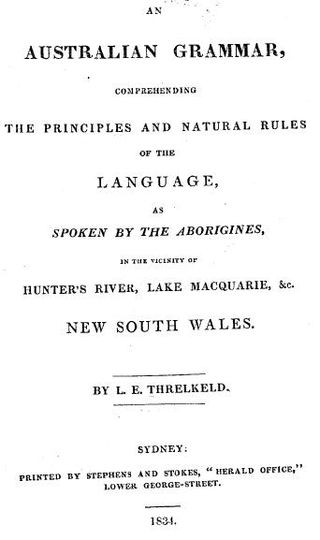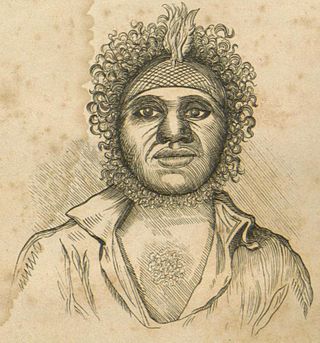Related Research Articles
The Wiradjuri people are a group of Aboriginal Australian people from central New South Wales, united by common descent through kinship and shared traditions. They survived as skilled hunter-fisher-gatherers, in family groups or clans, and many still use knowledge of hunting and gathering techniques as part of their customary life.

The Wonnarua people, otherwise written Wanarruwa, are a group of Aboriginal Australian people united by strong ties of kinship, and who survived in family groups or clans scattered along the inland area of what is now known as the Upper Hunter Valley, New South Wales, Australia. Their creation spirit is Baiami, also known as Koin, the creator of all things and the Keeper of the Valley.
Awabakal is an Australian Aboriginal language that was spoken around Lake Macquarie and Newcastle in New South Wales. The name is derived from Awaba, which was the native name of the lake. It was spoken by Awabakal and Wonnarua peoples.

The Awabakal people, are those Aboriginal Australians who identify with or are descended from the Awabakal tribe and its clans, Indigenous to the coastal area of what is now known as the Hunter Region of New South Wales. Their traditional territory spread from Wollombi in the west, to the Lower Hunter River near Newcastle and Lake Macquarie in the north.

An Australian grammar : comprehending the principles and natural rules of the language, as spoken by the Aborigines in the vicinity of Hunter's River, Lake Macquarie, &c. New South Wales is a book written by Lancelot Edward Threlkeld and published in Sydney in 1834. It is a grammar of the Awabakal language.

Kuringgai is an ethnonym referring to an Indigenous Australian people who once occupied the territory between the southern borders of the Gamilaraay and the area around Sydney, and a historical people with its own distinctive language, located in part of that territory.

Darkinjung is an Australian Aboriginal language, the traditional language of the Darkinjung people. While no audio recordings of the language survive, several researchers have compiled wordlists and grammatical descriptions. It has been classified as a language no longer fully spoken and it can be classified as needing a language renewal program. It was spoken adjacent to Dharuk, Wiradhuri, Gamilaraay, and Awabakal. The Darkinjung tribe occupied a small part of southeastern Australia inside what is now the New South Wales area. They likely inhabited a considerable tract of land within Hunter, Northumberland, and Cook counties.
The Central New South Wales languages are a largely geographic grouping of Australian Aboriginal languages within the traditional Pama–Nyungan family, partially overlapping the Kuri subgroup of the Yuin–Kuric languages.
The Gathang language, also spelt Gadjang, Kattang, Kutthung, Gadhang, Gadang and previously known as Worimi, is an Australian Aboriginal language or group of dialects. The three known dialects are Birrbay, Guringay, and Warrimay, which are used by the Worimi, Guringay, and Birrbay peoples. It became dormant during the latter half of the 20th century, but has been revived as of the 21st century.

Lancelot Edward Threlkeld was an English missionary, primarily based in Australia. He was married twice and survived by sons and daughters from both marriages. Threlkeld is known for his work with Biraban in recording and publishing English translations of the Awabakal language.
Diyari or Dieri is an Australian Aboriginal language spoken by the Diyari people in the far north of South Australia, to the east of Lake Eyre. It was studied by German Lutheran missionaries who translated Christian works into the language in the late 19th and early 20th centuries, so that it developed an extensive written form. Only a few fluent speakers of Diyari remained by the early 21st century, but a dictionary and grammar of the language was produced by linguist Peter K. Austin, and there is a project under way to teach it in schools.

Biraban was a leader of the Awabakal people, an Aboriginal Australian people who lived in the area around what is today Lake Macquarie. His native name prior to Awabakal initiation was We-pohng; his naming as Biraban is reference to his totemic relationship with the eaglehawk.

Sandgate is a suburb of Newcastle, New South Wales, Australia, located 11 kilometres (6.8 mi) from Newcastle's central business district. It is part of the City of Newcastle local government area. The Awabakal and Worimi people were the first to live in Newcastle.
The Worimi people are Aboriginal Australians from the eastern Port Stephens and Great Lakes regions of coastal New South Wales, Australia. Before contact with settlers, their people extended from Port Stephens in the south to Forster/Tuncurry in the north and as far west as Gloucester.

Mount Yengo is a mountain that is located in the Lower Hunter region of New South Wales, in eastern Australia. The 668-metre (2,192 ft) mountain is part of the Calore Range, part of the Great Dividing Range, and is situated within the Yengo National Park, approximately 3 kilometres (1.9 mi) east of the Macdonald River and 17 kilometres (11 mi) east by south of Putty.

Gumbaynggir is an Australian Aboriginal language spoken by the Gumbaynggirr people, who are native to the Mid North Coast of New South Wales.

The Yuin–Kuric languages are a group of mainly extinct Australian Aboriginal languages traditionally spoken in the south east of Australia. They belong in the Pama–Nyungan family. These languages are divided into the Yuin, Kuri, and Yora groups, although exact classifications vary between researchers. Yuin–Kuric languages were spoken by the original inhabitants of what are now the cities of Sydney and Canberra.
The Arakwal are an Aboriginal Australian people of the state of New South Wales.
Reverend Dr John Fraser was an Australian ethnologist, linguist, school headmaster and author of many scholarly works. He is known for his revised and expanded version of Lancelot Threlkeld's 1834 work, An Australian Grammar, with the new title An Australian language as spoken by the Awabakal, the people of Awaba or Lake Macquarie being an account of their language, traditions and customs / by L.E. Threlkeld; re-arranged, condensed and edited with an appendix by John Fraser (1892). In this, Fraser created new divisions and terminology for some Aboriginal groups in New South Wales.
The Yaran language, also called Bindjali, is an extinct language spoken around the Padthaway district by the Bodaruwitj. William Haynes, an earlier resident of the area, provided E.M.Curr with two distinct vocabularies of the area, which he designated as that of the Tatiara. Norman Tindale compiled a word-list relying on information supplied to him by Milerum, whose mother Lakwunami was a Potaruwutj from the Keilira region. R.M: Dixon managed to elicit a vocabulary of Bindjali from a Bordertown informant, Bertie Pinkie, as late as 1973. In his classification, Polinjunga, one of the alternative names for the Bodaruwitj, or a clan name of the same, is listed as a dialect of the Bungandidj-Kuurn Kopan Noot subgroup of the Kulinic languages.
References
- ↑ "Awaba electronic database: Language" . Retrieved 26 January 2010.[ dead link ]
- ↑ Moseley, Christopher (2007). Encyclopedia of the World's Endangered Languages. Routledge. ISBN 978-0700711970.
- ↑ Sati, Wiriya (2 April 2019). "Revitalising the Aboriginal language Gathang is about learning and speaking it together every day". ABC news. Retrieved 12 September 2019.
- ↑ Dixon, R. M. W. (2002). Australian Languages: Their Nature and Development. Cambridge University Press.